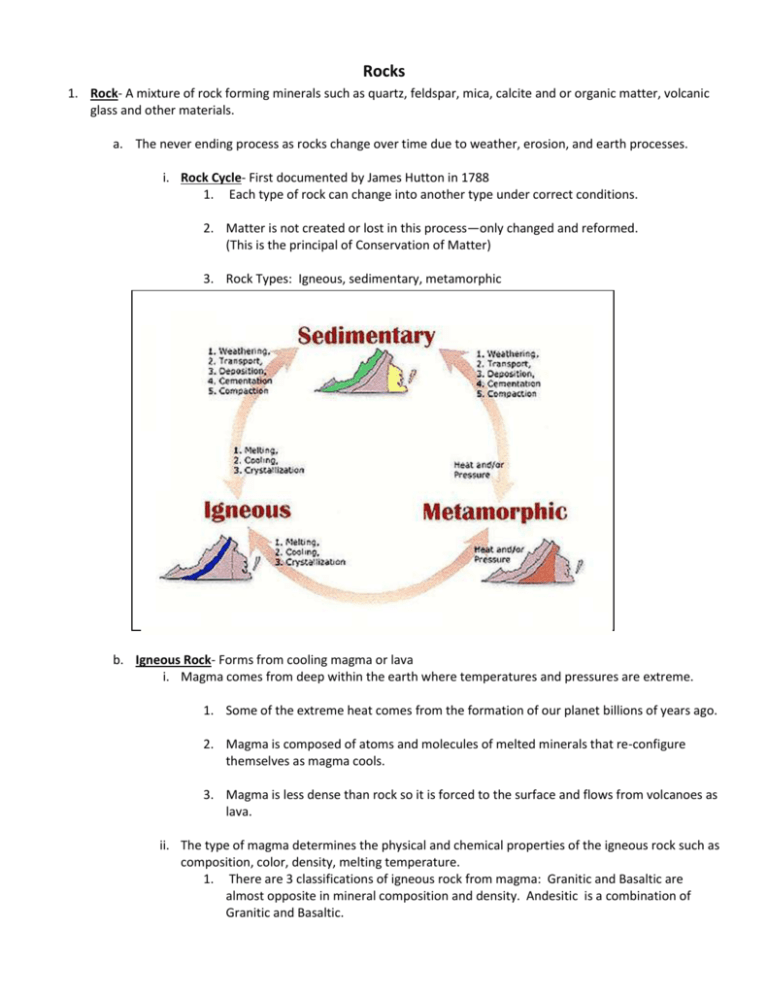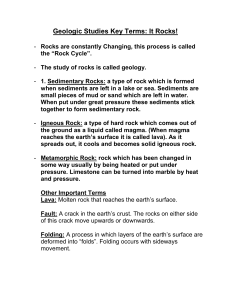Ch 4 Rocks Outline
advertisement

Rocks 1. Rock- A mixture of rock forming minerals such as quartz, feldspar, mica, calcite and or organic matter, volcanic glass and other materials. a. The never ending process as rocks change over time due to weather, erosion, and earth processes. i. Rock Cycle- First documented by James Hutton in 1788 1. Each type of rock can change into another type under correct conditions. 2. Matter is not created or lost in this process—only changed and reformed. (This is the principal of Conservation of Matter) 3. Rock Types: Igneous, sedimentary, metamorphic b. Igneous Rock- Forms from cooling magma or lava i. Magma comes from deep within the earth where temperatures and pressures are extreme. 1. Some of the extreme heat comes from the formation of our planet billions of years ago. 2. Magma is composed of atoms and molecules of melted minerals that re-configure themselves as magma cools. 3. Magma is less dense than rock so it is forced to the surface and flows from volcanoes as lava. ii. The type of magma determines the physical and chemical properties of the igneous rock such as composition, color, density, melting temperature. 1. There are 3 classifications of igneous rock from magma: Granitic and Basaltic are almost opposite in mineral composition and density. Andesitic is a combination of Granitic and Basaltic. iii. Intrusive Igneous Rocks 1. Form as minerals re-crystallize as magma cools below the surface 2. Crystals, or mineral grains, are large because magma is very slow cooling. a. Granite is the most common intrusive igneous rock. i. Granitic magma is thick and stiff and is “felsic” having a very high silica content and low iron or magnesium content. Because it lacks heavy minerals, it is not very dense. iv. Extrusive Igneous 1. Form as lava cools on the surface 2. Produces fine mineral grains which are very small because lava cools quickly due to air and water. a. Basalt is the most common extrusive igneous rock. i. Basalt is formed from extremely runny basaltic lava which is very rich in iron and magnesium and poor in silica. Basalt is “mafic” because of its dark color and high density. v. Volcanic Glass 1. Forms so quickly that no mineral grains can form. a. Pumice, obsidian, and scoria are examples of volcanic glass. c. Metamorphic Rocki. Forms as rocks change due to… 1. intense temperatures—Temperatures increase with depth. Extreme temperatures cause rock to melt or mineral grains within the rock to change shape. 2. Intense pressures—Pressure increases with depth. Extreme pressures cause minerals to exchange atoms with other minerals to form new larger minerals. 3. or the presence of hot, watery fluids. –The combination of water and dissolved elements cause chemical changes to the rock in contact with the hot fluids. ii. Changes may change the form or the composition of a rock iii. Metamorphic rock can form from every type of rock 1. Parent rocks produce predictable metamorphic rocks because of their compositions. a. Examples- Shale will metamorphose into slate. With increased temperatures and pressures, slate will metamorphose into phylite then schist and finally gneiss. In this case, shale is the parent rock. iv. Classifying Metamorphic Rocks 1. Foliated a. Mineral grains flatten and line up in parallel layers giving it a “banded” appearance. These layers can be separated along these foliations b. Sometimes mineral grains are packed so tightly due to extreme pressure that no separation is possible between bands. It is “water tight”. i. Gneiss, slate and shale are examples of foliated metamorphic rock. 2. Nonfoliated a. Mineral grains grow but do not form bands or layers. i. Example: Sandstone with heat and pressure changes into quartzite ii. Example: Limestone with heat and pressure changes into marble d. Sedimentary Rock i. Forms from sediments—tiny pieces of rock or organic material ii. Form when minerals form from solutions. iii. Classifications of Sedimentary Rock 1. Detrital Sedimentary Rock a. Form when pieces of other rocks wear away and are re-deposited and cemented together to form solid rock. b. Detrital Sedimentary rock is granular in texture c. Named from the shapes and sizes of the sediments that form them: i. Conglomerate-Large rounded sediments like pebbles ii. Breccia-Large jagged sharp sediments iii. Sandstone-Smaller sediments about the size of a grain of sand iv. Siltstone-Even smaller sediments d. Process: i. Rock is eroded or “weathered” by air, water or ice ii. Compaction: Sediments are carried by air or water or wind to a different location and are re-deposited in layer after layer over thousands of years. Pressure from the layers above press the layers beneath together forming solid rock. iii. Cementation / “Lithification”: Large sediments are “glued” together. Water seeps into the spaces between the large sediments and dissolved minerals grow out of solution. They act like cement to hold the sediments together. Usually the quartz or calcite work to cement sedimentary rock layers together. 2. Chemical Sedimentary Rock- Not formed from pieces of pre existing rock. a. Form when minerals come out of solution to form sediments and rocks. i. Limestone—forms when calcite is dissolved in ocean water and forms massive deposits as pre existing oceans evaporated over millions of years. ii. Halite /Rock Salt—Massive deposits form as ocean water containing dissolved minerals evaporates 3. Organic Sedimentary Rock- Form from the remains of once living things. a. Limestone—fossil rich sedimentary rock b. Coquina- Rock made only from the shells of once living things. c. Chalk- Made from microscopic shells of once living things. d. Coal-Remains of plants and animals that existed millions of years ago during the Carboniferous period i. Important source of energy and fuel.





